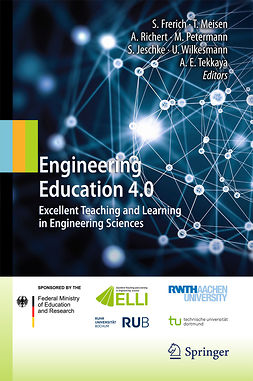Wassong, Thomas
Mit Werkzeugen Mathematik und Stochastik lernen – Using Tools for Learning Mathematics and Statistics
1. Abstrakte Mathematik und Computer
Willi Dörfler
2. Der Body-Mass-Index – von Quetelet zu Haldane
Hans Niels Jahnke
3. Unterrichtsgestaltungen zur Kompetenzförderung: zwischen Instruktion, Konstruktion und Metakognition
Stanislaw Schukajlow
4. Low Achievers’ Understanding of Place Value – Materials, Representations and Consequences for Instruction
Petra Scherer
5. Visual integration with stock-flow models: How far can intuition carry us?
Peter Sedlmeier, Friederike Brockhaus, Marcus Schwarz
6. Games, Data, and Habits of Mind
William Finzer
7. Caging the Capybara: Understanding Functions through Modeling
Tim Erickson
8. Visualisieren – Explorieren – Strukturieren: Multimediale Unterstützung beim Modellieren von Daten durch Funktionen
Markus Vogel
9. Change point detection tasks to explore students’ informal inferential reasoning
Joachim Engel
10. Eine kleine Geschichte statistischer Instrumente: vom Bleistift über R zu relax
Hans Peter Wolf
11. Implications of technology on what students need to know about statistics
Arthur Bakker
12. Tools for Learning Statistics: Fundamental Ideas in Statistics and the Role of Technology
Gail Burrill
13. Chance Re-encounters: 'Computers in Probability Education’ revisited
Dave Pratt, Janet Ainley
14. Multiple representations as tools for discovering pattern and variability – Insights into the dynamics of learning processes
Susanne Schnell, Susanne Prediger
15. EDA Instrumented Learning with TinkerPlots
Dani Ben-Zvi, Tali Ben-Arush
16. Zur Erfassung sprachlicher Einflüsse beim stochastischen Denken
Sebastian Kollhoff, Fanco Caluori, Andrea Peter-Koop
17. The epistemological character of visual semiotic means used in elementary stochastics learning
Judith Stanja, Heinz Steinbring
18. Contexts for Highlighting Signal and Noise
Clifford Konold, Anthony Harradine
19. Simulation als Bindeglied zwischen der empirischen Welt der Daten und der theoretischen Welt des Zufalls
Andreas Eichler
20. Modelling and Experiments – An Interactive Approach towards Probability and Statistics
Manfred Borovcnik
21. Using the software FATHOM for learning and teaching statistics in Germany – A review on the research activities of Rolf Biehler’s working group over the past ten years
Tobias Hofmann, Carmen Maxara, Thorsten Meyfarth, Andreas Prömmel
22. Konfektionsgrößen näher betrachtet – Ein Vorschlag zur Lehrerausbildung in Stochastik
Katja Krüger
23. Konzeptualisierung unterschiedlicher Kompetenzen und ihrer Wechselwirkungen, wie sie bei der Bearbeitung von stochastischen Simulationsaufgaben mit dem Computer auftreten
Carmen Maxara
24. Explorative Datenanalyse und stochastische Simulationen mit Tinker- Plots – erste Einsätze in Kassel & Paderborn
Daniel Frischemeier, Susanne Podworny
25. Wondering, Wandering or Unwavering? Learners’ Statistical Investigations with Fathom
Katie Makar, Jere Confrey
26. Preparing teachers to teach conditional probability: a didactic situation based on the Monty Hall problem
Carmen Batanero, J. Miguel Contreras, Carmen Díaz, Gustavo R. Cañadas
27. Teaching Statistical Thinking in the Data Deluge
Robert Gould, Mine Çetinkaya-Rundel
28. Students’ difficulties in practicing computer-supported statistical inference: Some hypothetical generalizations from a study
Maxine Pfannkuch, Chris J. Wild, Matt Regan
29. Using TinkerPlots™ to develop tertiary students' statistical thinking in a modeling-based introductory statistics class
Robert delMas, Joan Garfield, Andrew Zieffler
30. TinkerPlots as an Interactive Tool for Learning about Resampling
Jane Watson
31. Math-Bridge: Closing Gaps in European Remedial Mathematics with Technology-Enhanced Learning
Sergey Sosnovsky
32. Mathematik als Werkzeug: Sicht- und Arbeitsweisen von Studierenden am Anfang ihres Mathematikstudiums
Michael Liebendörfer, Laura Ostsieker
33. Der operative Beweis als didaktisches Instrument in der Hochschullehre Mathematik
Leander Kempen
34. Werkstattbericht der Arbeitsgruppe "Mathematik in den Ingenieurwissenschaften"
Markus Hennig, Axel Hoppenbrock, Jörg Kortemeyer, Bärbel Mertsching, Gudrun Oevel
35. Das Deutsche Zentrum für Lehrerbildung Mathematik (DZLM)
Jürg Kramer, Thomas Lange
Keywords: Mathematics, Mathematics, general, Mathematics Education, Mathematical Software
- Author(s)
- Wassong, Thomas
- Frischemeier, Daniel
- Fischer, Pascal R.
- Hochmuth, Reinhard
- Bender, Peter
- Publisher
- Springer
- Publication year
- 2014
- Language
- de
- Edition
- 2014
- Page amount
- 11 pages
- Category
- Natural Sciences
- Format
- Ebook
- eISBN (PDF)
- 9783658031046











